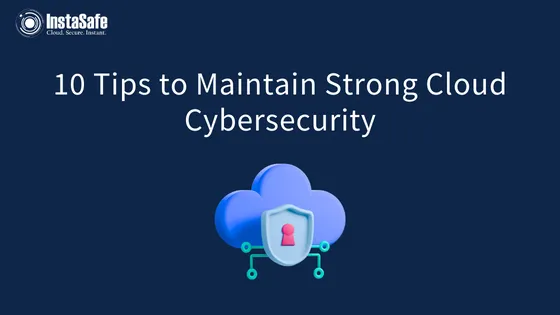10 Tips to Maintain Strong Cloud Cybersecurity

Nearly all businesses today possess a substantial amount of sensitive data stored in the cloud. Moreover, with the transition to remote work, more data than ever is stored in cloud-based applications. However, with the majority of employees using personal devices, a company's "attack surface" expands, creating more opportunities for hackers to breach security measures.
Cloud-based cyber security is causing worry for 9 out of 10 cybersecurity professionals, with their primary concerns being data loss and leakage (67%), threats to data privacy (61%), and breaches of confidentiality (53%).
Thus, we enlisted 10 tips on how to secure cloud data and maintain strong cloud cyber security. Before we dive into the solutions, let's first view the definition of cloud cyber security.
What is Cloud Cyber Security?
Cloud cyber security, or cloud computing security, is a set of protocols intended to safeguard cloud-based infrastructure, software, and data. These protocols oversee user authentication, control access to data, and guarantee the confidentiality of information.
The purpose of employing cloud security in a company's cloud environment is to shield data from various forms of cyberattacks, such as distributed denial of service (DDoS), malware, hackers, and unauthorised user access or misuse.
10 Essential Tips for Maintaining Cloud Cyber Security
1. Deploy a Multi-factor Authentication (MFA) Solution
It is recommended to use Multi-Factor Authentication (MFA) instead of relying solely on the traditional username and password combination to enhance the security of user accounts and prevent hackers from gaining access to online business data and applications. MFA is a cost-effective security measure that ensures only authorised individuals can log in to your cloud applications and access sensitive data, whether on-premise or off-premise.
2. Prioritise End-to-End Security Monitoring
An antivirus program and internal security processes are no longer sufficient to protect a company from cyber-attacks and security breaches. Businesses need good cyber threat intelligence to stay up-to-date on potential threats to achieve end-to-end security monitoring. An efficient security monitoring system is essential for detecting and identifying suspicious activity. Finally, businesses need a technological stack to rely on to contain any security incidents that may arise.
3. Establish a Data Backup Strategy
It is essential to have a reliable data backup plan to safeguard against the risk of permanent data loss in the evolving cloud environment. This step protects not only your data but also your business, providing reassurance and peace of mind.
4. Create Comprehensive Cloud Governance Policies
Merely certifying a cloud application is not enough; it is crucial to establish comprehensive cloud governance policies that ensure compliance with both internal and external data privacy regulations.
This includes conducting regular health checks and risk assessments and staying up-to-date with the constantly evolving security landscape. By implementing these policies, you can minimise potential security threats and maintain control over your cloud applications.
5. Make Use of Encryption
Encryption is essential for maintaining cloud-based cyber security, as it helps safeguard data from unauthorised access. By transforming data into a coded form that can only be decoded with the correct key, encryption makes it much more difficult for hackers to obtain sensitive data.
6. Implement Access Control and Endpoint Security
Access control and endpoint security are two additional crucial security measures. Access control solutions restrict data and resource access, preventing unauthorised individuals from accessing sensitive data.
Endpoint security, on the other hand, protects network-connected devices from a range of threats, such as malware and viruses.
7. Incorporate Identity and Access Management
To effectively manage access to company data and prevent breaches or leaks, it is important to have a dedicated concept for privileged identity and access management.
This concept should incorporate identity separation of duties, roles, and authorisations and dedicated monitoring for privileged access. The security monitoring platform should also include direct integrations to ensure comprehensive monitoring and protection.
8. Choose an Efficient Password Method
Maintaining effective password security is crucial for protecting data. It is recommended to use strong passwords that are difficult for others to guess, consisting of a mix of at least eight characters with a combination of uppercase and lowercase letters, numbers, and special characters.
9. Offer Employees Regular Security Training
While cloud platforms generally have robust defences, hackers may still attempt to bypass them by stealing employee login credentials through social engineering attacks like phishing.
Thus, it is important to provide security training to employees regularly. This will enable them to recognise and avoid potential threats, ultimately strengthening overall security measures.
10. Understand the Shared Responsibility Model
In cloud cybersecurity, the shared responsibility model involves both the cloud service provider and the customer taking responsibility for protecting data and applications. The provider secures the infrastructure, while the customer secures their data and applications. Here, it's crucial for both parties to understand their responsibilities, including encryption, to improve cloud-based cyber security.
Final Words
As companies shift their operations to the cloud, it is crucial to consider the top cloud security issues during the design of the new cloud infrastructure.
InstaSafe offers a Secure Multi-Cloud Access solution that is one of the most reliable technologies available to secure your business's cloud infrastructure, simplify cloud access, and enhance employee productivity.
Contact us or schedule a demo today to learn more!
Key Products
MFA | I&AM | ZTNA | Zero Trust Application Access | Secure Enterprise Browser
Key Features
Single Sign On | Endpoint Security | Device Binding | Domain Joining | Always On VPN | Contextual Based Access | Clientless Remote Access | Device Posture Check
Key Solutions
VPN Alternatives | DevOps Security | Cloud Application Security | Secure Remote Access | VoIP Security
